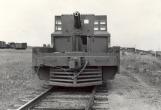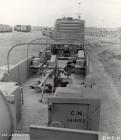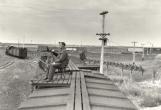1
In December 1941, the "War in the Pacific" erupted when Japan launched a series of surprise attacks on military troops stationed throughout the Pacific. Japan shocked the world with devastating attacks on Pearl Harbor and Hong Kong."Canada was fearful at that time of the Japanese and our west coast faces Japan and I think were, that the whole country were fearful that Canada could or might be attacked along the west coast?"
Suddenly the west coast of the United States and Canada was threatened. Prince Rupert, B.C, quickly became an important port for shipping supplies to Alaska, and was the host to large numbers of Canadian and American forces. The security of the CNR 'North' railway line, which followed the Skeena River for 80 miles from Terrace B.C. to the Pacific Coast port of Prince Rupert, became a concern.
To protect the vital rail link, the Canadian Army Engineering Branch came up with what was later known as one of the best-kept secrets of the war, Canada's No. 1 Armoured Train.
In the spring of 1942 blueprints from Ottawa and materials from Halifax were shipped to the Transcona Shops. Construction began to armour plate the rail cars and engine.
"What can I tell you about the first impressions of the armoured train..."
"The cars started to come in the shop, the drawings appeared for what we had to do, and we just went at it just the same we would repairing any other cars except that it was heavier work, much heavier."
The work that took place in the Transcona Shops was considered a military secret:
"We were not privileged to much knowledge about the armoured train it was a secret endeavour" recalled Jim Potter. "The armoured personnel were there at all times, 24 hours a day?They were in full military gear."
"It was a secretive operation, besides my job as a Carman I was also the company photographer and of course I was taken to one side and warned not to take any pictures."
What happened to armoured train during the war?
"What happened to it during the war. It was destined for the west coast. While we were doing the car equipment that would take all the search lights and guns and all that sort of stuff, the Motive Power in our Transcona Shops was doing the locomotive which was one of the first diesel locomotives and armour plate you know is thick and heavy and they found that it was too heavy to travel across some of the trestle bridges in British Columbia. That was a disappointment to some. And of course the whole train was much heavier than a normal train would be. There weren't many cars you know, six or seven but they were all much heavier than they would have been because of the application of the armour plate. It was a heavy job.
"It made it to the west coast", recalled Jim Potter. "The cost of it must have been enormous."
The first six cars were delivered to Terrace, B.C. on July 22, 1942. They were put into service seven days later. On August 6th, the base of operations was moved to the halfway point of Tvee so that the train could be closer to most vulnerable area, the mouth of the Skeena River.
Operations continued but serious problems plagued the armoured train. The vibration of the train loosened bolts that held gun mountings; there was trouble with the searchlights, static electricity discharge cause radio communications to go dead when the whistle was blown; and to make matters worse, the train was to heavy for the tracks and damaged the railway line that the train was trying to protect.
To remedy the numerous problems the train was sent to the Vancouver CNR workshops in early September and was returned to service on November 21, 1942. Operations continued through September 1943.
3
Mr. Jim Potter unveils a plaque inducting Transcona into the Railway Hall of Fame7 February 2004
141 Regent Avenue West, Winnipeg, Manitoba, Canada
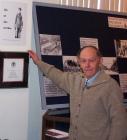
4
"Canada was fearful at that time of the Japanese and our west coast faces Japan and I think were, that the whole country were fearful that Canada could or might be attacked along the west coast?"Suddenly the west coast of the United States and Canada was threatened. Prince Rupert, B.C, quickly became an important port for shipping supplies to Alaska, and was the host to large numbers of Canadian and American forces. The security of the CNR 'North' railway line, which followed the Skeena River for 80 miles from Terrace B.C. to the Pacific Coast port of Prince Rupert, became a concern.
5
What it was like to build the Armoured Train14 September 2004
141 Regent Avenue West, Winnipeg, Manitoba, Canada

6
"What can I tell you about the first impressions of the armoured train...""The cars started to come in the shop, the drawings appeared for what we had to do, and we just went at it just the same we would repairing any other cars except that it was heavier work, much heavier."
7
The anti aircraft gun car and the searchlight car from the Armoured Train15 July 1942
Transcona, Manitoba, Canada
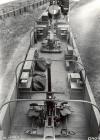
8
The work that took place in the Transcona Shops was considered a military secret:"We were not privileged to much knowledge about the armoured train it was a secret endeavour" recalled Jim Potter. "The armoured personnel were there at all times, 24 hours a day?They were in full military gear."
"It was a secretive operation, besides my job as a Carman I was also the company photographer and of course I was taken to one side and warned not to take any pictures"
10
The anti aircraft gun car and the searchlight car from the Armoured Train15 July 1942
Transcona, Manitoba, Canada
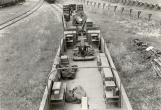
11
Mr. Jim Potter, a retired Transcona Shops employee, explains the fate of the Armoured Train14 September 2004
141 Regent Avenue West, Winnipeg, Manitoba, Canada

12
What happened to armoured train during the war?"What happened to it during the war. It was destined for the west coast. While we were doing the car equipment that would take all the search lights and guns and all that sort of stuff, the Motive Power in our Transcona Shops was doing the locomotive which was one of the first diesel locomotives and armour plate you know is thick and heavy and they found that it was too heavy to travel across some of the trestle bridges in British Columbia. That was a disappointment to some. And of course the whole train was much heavier than a normal train would be. There weren't many cars you know, six or seven but they were all much heavier than they would have been because of the application of the armour plate. It was a heavy job.
"It made it to the west coast", recalled Jim Potter. "The cost of it must have been enormous."
